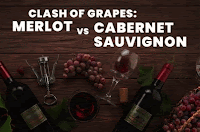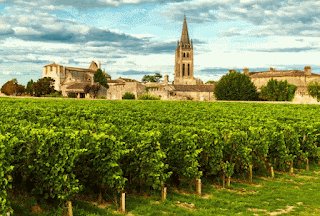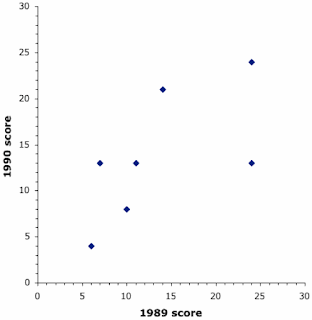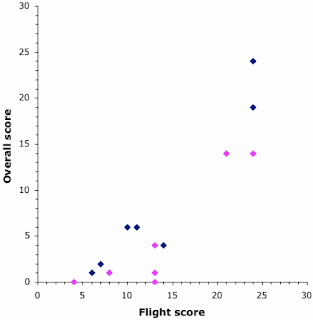In last week’s post, I used some data from a wine-tasting conducted by Bob Henry (What happens when you score wines at comparative tastings?). I looked at the odd effect in wine tastings, where the preferences for wines within a single flight of similar wines does not necessarily match the preferences produced when two flights are combined into a single group. Wine tasters are people, after all, and we reserve the right to do things our own way!
This week, I will take a retrospective look at three more of Bob’s tastings, from the end of the 1990s, in which his tasters compared red Bordeaux wines and California cabernets at the same session. Each tasting covered a different vintage, but only a few of the wineries were repeated across the vintages.
There were 15 participants at the Winter 1998 tasting of the 1985 vintage (wines 13 years old), with 8 Bordeaux wines and 8 California wines. There were 15 participants at the Summer 1997 tasting of the 1986 vintage (wines 11 years old), with 6 Bordeaux wines and 7 California wines. There were 16 participants at the Autumn 1997 tasting of the 1990 vintage (wines 7 years old), with 7 Bordeaux wines and 7 California wines.
The wines were tasted blind (ie. the bottle in a paper bag, although the order of wines was not random). Each person was asked to rank-order their three preferred wines from the total wines tasted for each vintage, which were then assigned points: 3 points for 1st preference, 2 points for 2nd preference, and 1 point for 3rd preference (yielding a total of 90, 90 and 96 points for the three tastings, respectively).
It is important to note that these results are relative only to each other, and there is thus no assessment of the wines on any absolute scale (eg. a score out of 100). Bob Henry made it clear in his comment on the previous post: “At my wine-tasting luncheons I never asked participants to assign a rating / score to any wine ... I knew each participant had her or his own interpretation of some undefined rating system ... I did believe that rank ordering (1st, 2nd, 3rd) would fairly elicit the degree of preference each participant found in the wines.” These results are from wine tasters, not wine critics.
The results of each of the tastings are summarized in these three tables. The wines are listed in decreasing score order within each tasting, with the California wines shown in bold-face.
There is usually one clearly preferred wine in each tasting (with a higher preference score than the others). The other wine preferences then drop off quickly, with quite a few wines at the bottom of each table that did not make it into anyone’s top-3 list.
In this regard, it is worth noting that Château Cheval Blanc (from the Saint-Émilion region of Bordeaux) makes it into into the Top-3 at all three tastings, while Château Margaux (Médoc First Growth) is in mid-table in all three cases. [1] Being a Bordeaux First Growth is not necessarily beneficial, apparently, although Château Mouton Rothschild (the other First Growth tasted) is at the top of the second table. Not all wines are always in form, apparently, especially when they are not at stage-managed events (Some wines are beyond criticism).
It is thus also interesting to note that what is clearly the top wine in the first tasting, Château Lynch–Bages, is actually a Médoc Fifth Growth of Bordeaux (the only one among the three tastings). The Médoc Second Growths tend to be down the lists a bit, while the Saint-Émilion wines tend to do quite well, in the top third of the lists. The Saint-Émilion wines are principally a Merlot blend, of course, rather than the Cabernet sauvignon of the Médoc. Château La Conseillante, a Merlot-based wine from Pomerol, also does well (in the first and third tastings).
Sadly, in all three tastings, the French wines were generally preferred to the U.S. Cabernet wines. The wines tasted cover many of the most famous names, mostly from the Napa Valley (Cabernet sauvignon is still Napa Valley’s top varietal; see: Napa County up 35% in crop value with record in wine grape production). Indeed, only the Caymus “Special Selection” (in the second and third tastings, but not the first tasting) and the Beringer “Reserve” (in the first tasting) got any sort of respectable placing. The Spottswoode did poorly in all three tastings, along with the Montelena in the second and third tastings, although the Dominus did better in the third tasting than it did in the first.
It is perhaps also of interest to compare these results to the current online review-site comments. Wine Searcher makes the current comments about the three vintages tasted:
1985 Vintage
Bordeaux: Excellent
California was the only major wine region outside of Europe to give a star performance.
1986 vintage
Bordeaux: Good
In the New World, both California and Australia enjoyed fantastic years.
1990 Vintage
Bordeaux: Legendary
In the New World, both California and Australia produced some fantastic wines.
These days, of course, the tendency is to note that the Bordeaux vintages are “Modern classic” wines (Bordeaux 2023: vintage overview), unlike the old-style vintages tasted here from the end of last century. Things have changed considerably for the Napa Valley in the ensuing quarter-century, as well, as they now give the Bordeaux wines a much clearer run for their money. However, there are recent comments that are clearly not in favour of California reds, compared to those from Europe (Dan Berger on wine: The reddish europhile).
Indeed, it is perhaps worth noting that most of the vineyards are composed of plants that are French vines grafted onto American rootstocks. This is due to the phylloxera outbreak in Europe, arising from transporting American vines to Europe (Did Darwin save wine?). Very few places in Europe avoided phylloxera (eg. Colares: wines by the waves). The US vines are also usually grafted, since the original French cultivars could not survive in the phylloxera-infested USA.
There are, of course, many many published comparisons of Napa wines with those of Bordeaux. One particularly relevant one here is that in Wine Spectator Sept. 15 1996, pp. 32—48.
[1] Bob Henry comments: “The 1990 Cheval Blanc is among the five best red wines I have ever tasted in my life. And has been every time I have tasted it. Simply sublime.”
Monday, May 13, 2024
Monday, May 6, 2024
What happens when you score wines at comparative tastings?
I rarely write about specific wines in this blog. However, I first learned about wine by doing comparative tastings in the early 1980s. My local “bottle shop” (or “liquor store” or “off-licence”, etc) in Australia would have a few bottles open on Thursday evening (late-night shopping night), which had been left as samples by distributors, in the hopes of getting the owner to stock them. We customers would comment.
Eventually, the proprietor realized that there were enough of us doing this that he could organize special comparative tastings on weekends, for which we would pay. I would often bring along a special old bottle in lieu of paying cash. I now do comparative tastings of my own, nearly 40 years later, to which I invite my vinous friends. *
It is therefore worth looking at the results of these sorts of comparisons, to see what we can learn. Bob Henry, who was introduced a couple of weeks ago (in the post: Some new notes on Rudy Kurniawan and his activities), has conducted many such tastings while “moonlighting” on weekends on the sales staff of leading wine stores around Los Angeles, and as an organizer of wine cellars for private parties in Los Angeles. I will look at a few tastings that he conducted in the mid—late 1990s. In particular, I will look at tastings that compared two distinct groups of wines on the same tasting occasion.
As a starter, there was a tasting of seven Bordeaux chateau wines from both the 1989 and 1990 vintages, tasted in the winter of 1994:
It is important to note that these results are relative only to each other, and there is thus no assessment of the wines on any absolute scale (eg. a score out of 100). The results are summarized in this first graph.
Clearly, the “best” (La Conseillante) and “worst” (La Mission Haut-Brion) wines were consistent across the two vintages; but otherwise there are some notable issues here. For example, three of the wines got the same score for the 1990 wine (13 points) but differed greatly from each other for the 1989 wine: 7 (Pichon-Baron), 11 (Léoville-Las Cases), and 24 (L’Angélus) points. Vinous things were apparently not consistent for these chateaux in those days.
This tells us nothing about how the two vintages compared, of course. So, at the end the participants were also asked to rank all 14 wines simultaneously, with points once again for their first, second and third preference — only then were the wine identities revealed. These results are summarized in this next graph, where the score from graph 1 is plotted horizontal and the overall score is vertical. The 1989 wines are in blue and the 1990 wines in pink.
Clearly, the 1989 wines were preferred to the 1990 wines, at this particular tasting, when the wines were still fairly young. Subsequent assessments usually place 1990 slightly ahead of 1989 (eg. Bordeaux vintage chart 1959 to today), although both vintages were streets ahead of the half-dozen Bordeaux vintages before and after them. [Bob has noted that the 1989 La Conseillante remains one of his all-time favorite wines in the world; and he has consistently declared that the 1989 red Bordeaux vintage ranks among the very best in half a century.]
However, the interesting thing is the apparent inconsistency that arises — wines do always get an overall score that matches their score within their own vintage flight. ** For example, three wines all scored 13 in the 1990 flight and yet got different overall scores (0, 1, 4). Even worse, several of the wines did better when compared overall (across the two vintages) than they did within their own vintage flight.
These results are quite illogical. This appears to be the answer to the question posed in the post’s title!
* “Baby Boomers prefer the luxury and educational experience of wine” (Millennials and Gen X want a wine vacation, not an education).
** What’s a wine flight and why is it called that?
Eventually, the proprietor realized that there were enough of us doing this that he could organize special comparative tastings on weekends, for which we would pay. I would often bring along a special old bottle in lieu of paying cash. I now do comparative tastings of my own, nearly 40 years later, to which I invite my vinous friends. *
It is therefore worth looking at the results of these sorts of comparisons, to see what we can learn. Bob Henry, who was introduced a couple of weeks ago (in the post: Some new notes on Rudy Kurniawan and his activities), has conducted many such tastings while “moonlighting” on weekends on the sales staff of leading wine stores around Los Angeles, and as an organizer of wine cellars for private parties in Los Angeles. I will look at a few tastings that he conducted in the mid—late 1990s. In particular, I will look at tastings that compared two distinct groups of wines on the same tasting occasion.
As a starter, there was a tasting of seven Bordeaux chateau wines from both the 1989 and 1990 vintages, tasted in the winter of 1994:
- Château L’Angélus
- Château Pichon Longueville Baron
- Château La Mission Haut-Brion
- Château Palmer
- Château La Conseillante
- Château Montrose
- Château Léoville-Las Cases.
It is important to note that these results are relative only to each other, and there is thus no assessment of the wines on any absolute scale (eg. a score out of 100). The results are summarized in this first graph.
Clearly, the “best” (La Conseillante) and “worst” (La Mission Haut-Brion) wines were consistent across the two vintages; but otherwise there are some notable issues here. For example, three of the wines got the same score for the 1990 wine (13 points) but differed greatly from each other for the 1989 wine: 7 (Pichon-Baron), 11 (Léoville-Las Cases), and 24 (L’Angélus) points. Vinous things were apparently not consistent for these chateaux in those days.
This tells us nothing about how the two vintages compared, of course. So, at the end the participants were also asked to rank all 14 wines simultaneously, with points once again for their first, second and third preference — only then were the wine identities revealed. These results are summarized in this next graph, where the score from graph 1 is plotted horizontal and the overall score is vertical. The 1989 wines are in blue and the 1990 wines in pink.
Clearly, the 1989 wines were preferred to the 1990 wines, at this particular tasting, when the wines were still fairly young. Subsequent assessments usually place 1990 slightly ahead of 1989 (eg. Bordeaux vintage chart 1959 to today), although both vintages were streets ahead of the half-dozen Bordeaux vintages before and after them. [Bob has noted that the 1989 La Conseillante remains one of his all-time favorite wines in the world; and he has consistently declared that the 1989 red Bordeaux vintage ranks among the very best in half a century.]
However, the interesting thing is the apparent inconsistency that arises — wines do always get an overall score that matches their score within their own vintage flight. ** For example, three wines all scored 13 in the 1990 flight and yet got different overall scores (0, 1, 4). Even worse, several of the wines did better when compared overall (across the two vintages) than they did within their own vintage flight.
These results are quite illogical. This appears to be the answer to the question posed in the post’s title!
* “Baby Boomers prefer the luxury and educational experience of wine” (Millennials and Gen X want a wine vacation, not an education).
** What’s a wine flight and why is it called that?
Subscribe to:
Posts (Atom)






